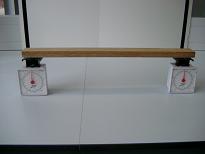Action and Reaction Forces
This model demonstrates what has been shown in Example 1-1, namely:
- The sum of reaction forces is always equal to the external force, W, regardless of the location of the external force.
- When the external force, W, is placed above one of the two supports, the reaction force at that support is equal to the external force but acts in the opposite direction and there is no reaction force at the other support.



Fig. 1-3a shows a wooden beam supported by two scales, one at each end. The scales are adjusted to zero when the beam is in place. Locate a weight of 454 grams at three different positions on the beam and note the readings on the two scales. It can be seen that:
- For the three positions of the weight, the sum of the readings (reactions) from the two scales is always equal to the weight (the external force), see Fig. 1-3b.
- The readings on the scales have a linear relation to the distance between the locations of the supports and the weight. The closer the weight is to one of the scales, the larger the reading on the scale. An extreme case occurs when the weight is placed directly over the left hand scale. The reading on the left hand scale is the same as the weight and the reading on the other scale is zero (Fig. 1-3c).
